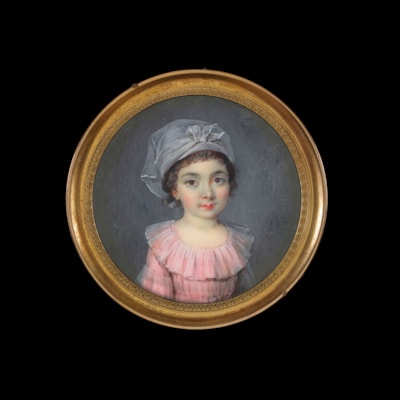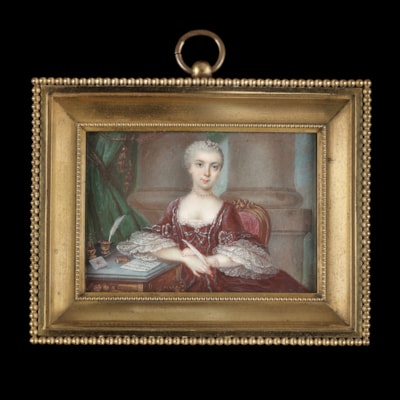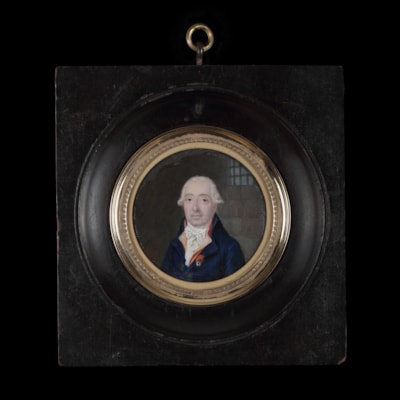FRENCH SCHOOL (18th century)
Portrait miniature of a Lady, wearing white gown, her hair powdered, set into a vari-coloured gold and painted papier-mache carnet-de-bal
Circa 1785
Watercolour on ivory
Set into a vari-coloured gold and painted papier-mache carnet-de-bal;
the rectangular case of slightly tapering shape, all sides set within within chased gold borders, the sides of the top applied with gold inscription "Keppsake", the borders chased with bands of laurel in gold, one side of the base with oval portrait miniature within a gold mount, the back within identical frame containing a gold monogram "AC" on a green silk ground, under glass; inside tablets and miniature pencil
The whole 97 mm (3 ⁷/₈ inches) high
SOLD
Carnets-de-bal were also known as ‘souvenir’, French for “to remember”. Small in size and compact, and often adorned with portrait miniatures, they were popular gifts exchanged among friends and lovers, symbolizing an elegant way to convey sentimental messages. Along with snuffboxes, carnets-de-bal were even given a royal gifts, used in courts in lieu of cash payments.
In 18th century Europe, Parisian goldsmiths, renowned for their craftsmanship, led the production of high quality carnets-de-bal, alongside other personal artifacts/accessories such as snuff boxes and sewing utensils. These boxes were coveted and admired among high society, produced from a variety of materials, the most luxurious ones being encrusted with diamonds, (see Met example). They were so fashionable as accessories, completely entrenched in social ritual, to the point that merchants advertised new carnets-de-bal with each changing season.
By the 19th century, the fashion for carnets-de-bal would evolve into little printed pasteboard booklets, often dangling on silken cords from a lady’s wrist (see Sotheby’s, Fabergé, Gold Boxes & Objects de Luxe, 15 November 2022, Lot 1271). This particular carnet-de-bal is a classic example of one, revealing a set of implements comprising of a pencil and ivory note-pad as you open it.

shipping notice
Worldwide shipping is included in all prices.
The Limner Company does not accept any responsibility for import duty, this is to be paid by the buyer.
Some stock items contain materials from endangered species which are governed by CITES regulations and will require a permit to export outside of Great Britain. If a certificate of export is required then this will be the responsibility of and paid for by the buyer .
you may also like













